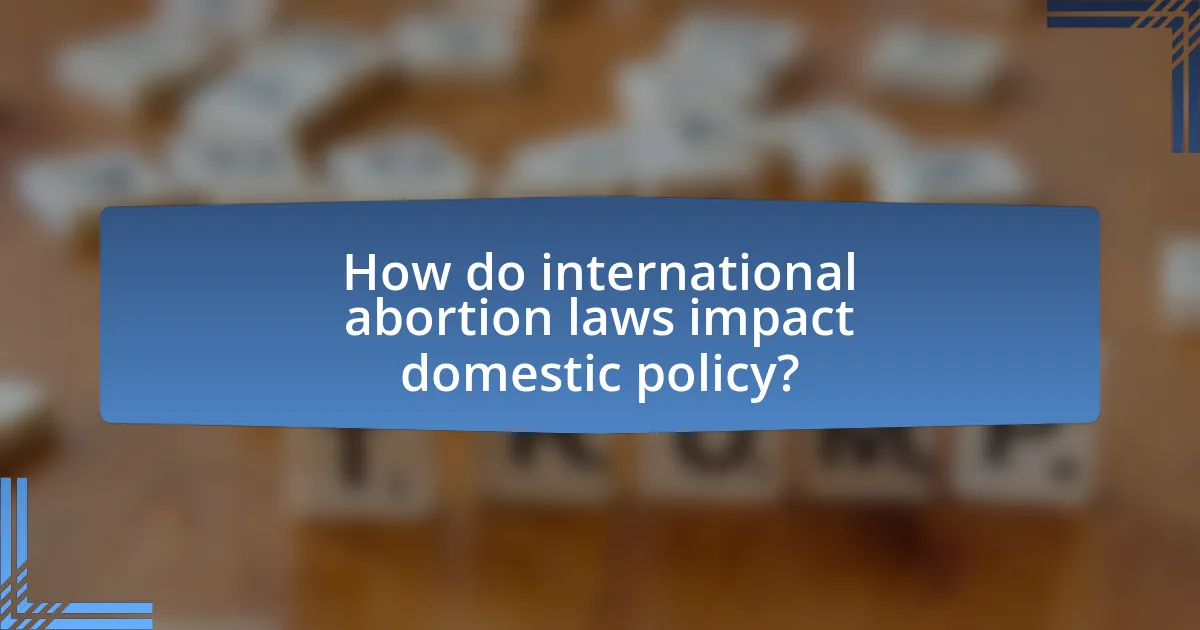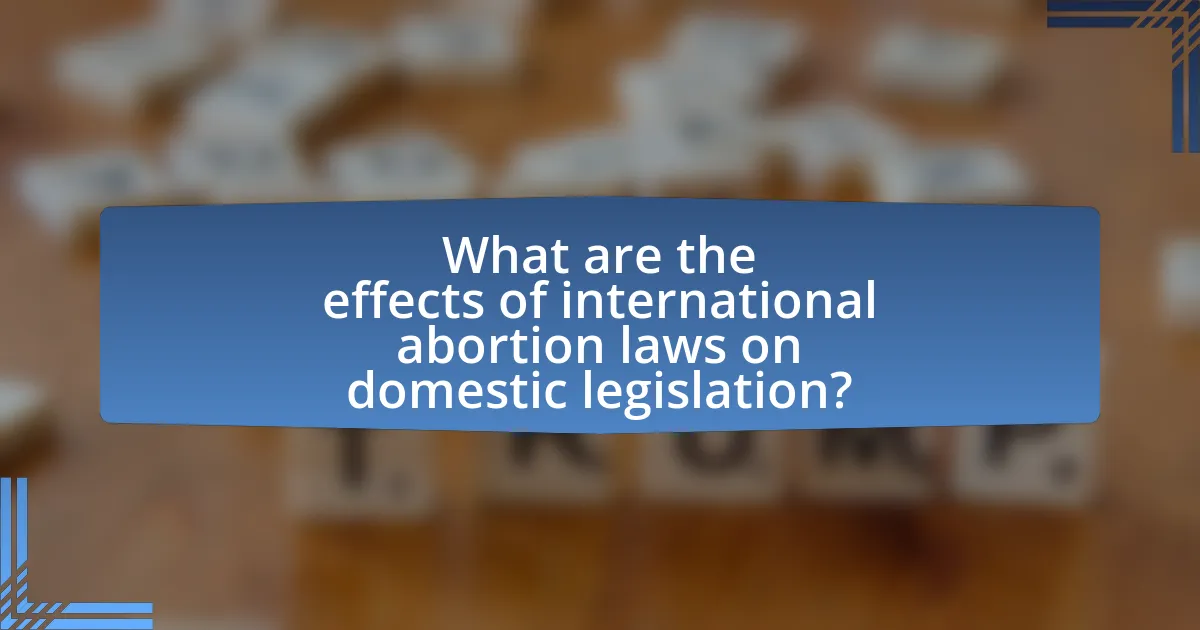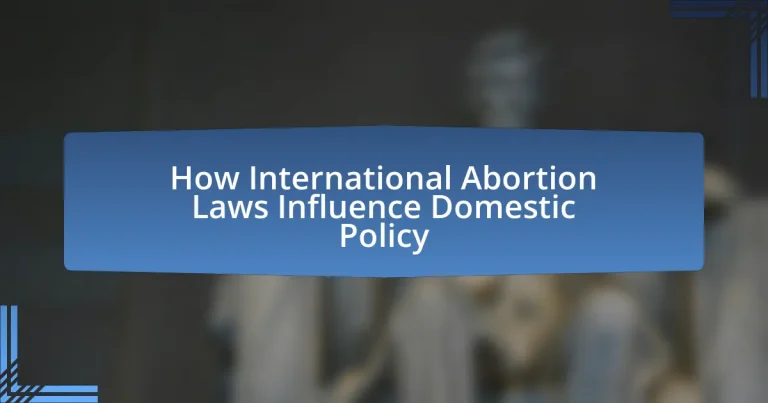The article examines how international abortion laws, such as the Convention on the Elimination of All Forms of Discrimination Against Women (CEDAW) and the International Covenant on Civil and Political Rights (ICCPR), shape domestic policies regarding reproductive rights. It highlights the influence of international treaties on national legislation, public health outcomes, and societal attitudes towards abortion. The article also discusses the role of international organizations in promoting abortion rights, the challenges countries face in aligning domestic laws with international standards, and the impact of cultural factors on this alignment. Additionally, it explores strategies for harmonizing international norms with local values and the importance of stakeholder engagement and education in this process.

How do international abortion laws impact domestic policy?
International abortion laws significantly influence domestic policy by shaping legislative frameworks, public health initiatives, and societal attitudes toward reproductive rights. For instance, countries that are signatories to international treaties, such as the Convention on the Elimination of All Forms of Discrimination Against Women (CEDAW), often align their domestic laws with the principles outlined in these agreements, leading to more progressive abortion policies. Research indicates that nations with supportive international frameworks tend to have lower maternal mortality rates and better access to reproductive health services, as seen in countries like Sweden and the Netherlands, which have comprehensive abortion laws influenced by international standards. This alignment not only reflects a commitment to global human rights norms but also fosters a more informed public discourse on reproductive health issues.
What are the key international abortion laws influencing domestic policies?
Key international abortion laws influencing domestic policies include the Convention on the Elimination of All Forms of Discrimination Against Women (CEDAW), the International Covenant on Civil and Political Rights (ICCPR), and the International Conference on Population and Development (ICPD) Programme of Action. CEDAW, adopted in 1979, mandates that countries eliminate discrimination against women, which has been interpreted to include access to safe abortion services. The ICCPR, established in 1966, emphasizes the right to life and personal autonomy, influencing countries to consider women’s rights in abortion legislation. The ICPD Programme of Action, adopted in 1994, promotes reproductive health and rights, encouraging nations to ensure access to safe abortion where legal. These international frameworks shape domestic laws by providing guidelines and standards that countries are encouraged to adopt, thereby impacting national policies on abortion.
How do treaties and agreements shape national abortion legislation?
Treaties and agreements shape national abortion legislation by establishing international norms and standards that countries are encouraged to adopt. For instance, treaties like the Convention on the Elimination of All Forms of Discrimination Against Women (CEDAW) promote women’s rights, including reproductive rights, influencing national laws to align with these international commitments. Countries that ratify such treaties often face pressure from international bodies and civil society to reform their abortion laws, leading to legislative changes that reflect these global standards.
What role do international organizations play in promoting abortion rights?
International organizations play a crucial role in promoting abortion rights by advocating for policy changes, providing funding, and facilitating international dialogue on reproductive health. Organizations such as the World Health Organization (WHO) and the United Nations (UN) have established guidelines and frameworks that emphasize the importance of safe and legal abortion as part of comprehensive healthcare. For instance, the WHO’s “Safe Abortion: Technical and Policy Guidance for Health Systems” outlines best practices for ensuring access to safe abortion services, which influences national policies. Additionally, international treaties and agreements, like the Convention on the Elimination of All Forms of Discrimination Against Women (CEDAW), obligate member states to uphold women’s reproductive rights, thereby impacting domestic legislation. These efforts collectively aim to reduce maternal mortality and promote gender equality, reinforcing the significance of abortion rights in global health and human rights agendas.
Why do countries adopt international abortion laws?
Countries adopt international abortion laws primarily to align their domestic policies with global human rights standards and public health objectives. By doing so, nations aim to ensure women’s reproductive rights, reduce maternal mortality rates, and promote gender equality. For instance, the World Health Organization reports that restrictive abortion laws contribute to unsafe procedures, leading to approximately 47,000 maternal deaths annually. Thus, adopting international abortion laws helps countries mitigate health risks and fulfill commitments to international treaties, such as the Convention on the Elimination of All Forms of Discrimination Against Women.
What are the motivations behind aligning domestic laws with international standards?
The motivations behind aligning domestic laws with international standards include the desire for legal consistency, the promotion of human rights, and the facilitation of international cooperation. Legal consistency ensures that domestic laws reflect widely accepted norms, which can enhance a country’s credibility on the global stage. The promotion of human rights is particularly relevant in the context of abortion laws, as international standards often advocate for women’s rights and reproductive health. Furthermore, aligning with international standards can facilitate international cooperation, as countries that adhere to these norms may find it easier to engage in trade, diplomacy, and other forms of collaboration. For instance, countries that align their abortion laws with international human rights standards may receive support from international organizations, which can lead to improved healthcare outcomes and social stability.
How do cultural and social factors influence this alignment?
Cultural and social factors significantly influence the alignment of international abortion laws with domestic policy by shaping public opinion and legislative priorities. For instance, in countries where religious beliefs strongly oppose abortion, such as in many predominantly Catholic nations, domestic laws often reflect these cultural values, leading to restrictive abortion policies despite international human rights frameworks advocating for reproductive rights. Additionally, social movements advocating for women’s rights can pressure governments to align domestic policies with international standards, as seen in countries like Ireland, where public campaigns led to the repeal of restrictive abortion laws in 2018, aligning with evolving international norms. This interplay demonstrates that cultural and social contexts are critical in determining how effectively international abortion laws are integrated into domestic legislation.

What are the effects of international abortion laws on domestic legislation?
International abortion laws significantly influence domestic legislation by shaping the legal frameworks and policies of individual countries. For instance, countries that are signatories to international treaties, such as the Convention on the Elimination of All Forms of Discrimination Against Women (CEDAW), often feel pressured to align their domestic abortion laws with international human rights standards. This alignment can lead to the liberalization of abortion laws in nations where restrictive policies previously existed.
Moreover, international advocacy and funding from organizations like the World Health Organization (WHO) and the United Nations (UN) can promote changes in domestic legislation by providing resources and support for reproductive health initiatives. Evidence shows that countries with strong international commitments tend to have more progressive abortion laws, as seen in nations like Canada and the Netherlands, which have adopted more liberal policies in response to international norms and pressures.
How do international laws affect the legal status of abortion in various countries?
International laws significantly influence the legal status of abortion in various countries by establishing frameworks that promote reproductive rights and health. For instance, treaties such as the Convention on the Elimination of All Forms of Discrimination Against Women (CEDAW) obligate signatory states to ensure women’s access to safe and legal abortion services. Countries that ratify CEDAW are encouraged to align their domestic laws with international standards, which can lead to legal reforms that expand abortion access. Additionally, the International Covenant on Civil and Political Rights (ICCPR) emphasizes the right to privacy and bodily autonomy, further supporting the argument for legal abortion. As a result, nations that adhere to these international agreements often experience shifts in public policy and legal frameworks that favor reproductive rights, reflecting a growing recognition of women’s health and autonomy on a global scale.
What changes have occurred in domestic laws following international pressure?
Domestic laws have undergone significant changes in response to international pressure, particularly in the realm of abortion rights. For instance, countries like Ireland and Argentina have reformed their abortion laws after facing scrutiny from international human rights organizations and advocacy groups. In 2018, Ireland repealed the Eighth Amendment, which had heavily restricted abortion access, following a public referendum influenced by international human rights standards. Similarly, in 2020, Argentina legalized abortion up to 14 weeks of pregnancy, a decision that was bolstered by international advocacy and support from organizations like the United Nations. These changes illustrate how international norms and pressures can lead to substantial shifts in domestic legislation regarding reproductive rights.
How do these changes vary across different regions?
Changes in international abortion laws vary significantly across different regions due to cultural, legal, and political factors. For instance, in North America, particularly the United States, recent shifts have led to increased restrictions in several states following the overturning of Roe v. Wade, reflecting a conservative backlash against previously liberal policies. In contrast, European countries like Sweden and the Netherlands maintain progressive abortion laws, allowing access and emphasizing women’s rights, which is supported by public health data showing lower maternal mortality rates associated with safe abortion practices. Meanwhile, in regions such as Latin America, countries like Argentina have recently legalized abortion, indicating a shift towards more liberal policies influenced by social movements and international pressure, while others remain highly restrictive, reflecting deep-rooted cultural beliefs. These regional variations illustrate how local contexts shape the implementation and impact of international abortion laws on domestic policy.
What challenges do countries face in implementing international abortion laws?
Countries face significant challenges in implementing international abortion laws, primarily due to cultural, legal, and political factors. Cultural opposition often stems from deeply rooted beliefs and values regarding reproductive rights, which can lead to public resistance against legal reforms. Legally, discrepancies between international standards and domestic laws create obstacles, as many countries have restrictive abortion laws that conflict with international human rights obligations. Politically, the influence of anti-abortion advocacy groups can hinder legislative progress, as seen in various nations where political leaders prioritize these groups’ agendas over international commitments. For instance, in the United States, the reversal of Roe v. Wade in 2022 demonstrated how domestic political shifts can directly impact the implementation of international norms regarding abortion rights.
What are the legal and political obstacles to compliance?
Legal and political obstacles to compliance with international abortion laws include conflicting national laws, political resistance from conservative factions, and lack of enforcement mechanisms. Many countries have laws that directly contradict international standards, creating legal dilemmas for compliance. Political resistance often stems from cultural and religious beliefs that oppose abortion, leading to legislative gridlock or outright rejection of international agreements. Additionally, the absence of robust enforcement mechanisms means that even when international laws are ratified, they may not be implemented effectively, as seen in various countries where local authorities prioritize national laws over international obligations.
How do public opinions and protests influence these challenges?
Public opinions and protests significantly influence challenges related to international abortion laws and their impact on domestic policy by shaping political discourse and prompting legislative changes. For instance, widespread public support for reproductive rights can lead to increased pressure on lawmakers to align domestic policies with the prevailing public sentiment, as seen in countries like Ireland, where public opinion shifted towards liberalizing abortion laws, resulting in the repeal of the Eighth Amendment in 2018. Additionally, organized protests can mobilize communities and draw media attention, compelling governments to address these issues more urgently, as demonstrated by the Women’s March in the United States, which highlighted the demand for reproductive rights and influenced political candidates’ platforms.

How can countries balance international abortion laws with local values?
Countries can balance international abortion laws with local values by engaging in inclusive dialogue that considers both global human rights standards and cultural beliefs. This approach allows policymakers to assess international guidelines, such as those from the World Health Organization, while also respecting the diverse ethical perspectives within their populations. For instance, countries like Canada have successfully integrated international norms by promoting reproductive rights while simultaneously addressing local concerns through public consultations and educational campaigns. This method not only aligns domestic policies with international expectations but also fosters societal acceptance and understanding of abortion-related issues.
What strategies can be employed to harmonize international and domestic policies?
To harmonize international and domestic policies, countries can adopt strategies such as aligning legal frameworks, engaging in multilateral agreements, and fostering intergovernmental cooperation. Aligning legal frameworks ensures that domestic laws reflect international standards, which can be seen in the adoption of treaties like the Convention on the Elimination of All Forms of Discrimination Against Women (CEDAW), which influences domestic gender equality laws. Engaging in multilateral agreements allows countries to commit to shared goals, as evidenced by the Global Strategy for Women’s, Children’s and Adolescents’ Health, which encourages nations to adopt policies that support reproductive rights. Fostering intergovernmental cooperation through platforms like the United Nations can facilitate dialogue and best practices, leading to more cohesive policy implementation across borders.
How can stakeholder engagement improve policy alignment?
Stakeholder engagement can improve policy alignment by ensuring that diverse perspectives and interests are considered in the policymaking process. When stakeholders, such as advocacy groups, healthcare providers, and affected communities, actively participate, they provide valuable insights that can lead to more comprehensive and effective policies. For instance, research by the World Health Organization indicates that inclusive stakeholder engagement in health policy development results in better health outcomes and increased public trust. This collaborative approach helps to identify potential conflicts and synergies among different policy objectives, ultimately leading to policies that are more aligned with the needs and values of the community.
What role does education play in bridging the gap between international norms and local beliefs?
Education plays a crucial role in bridging the gap between international norms and local beliefs by fostering understanding and critical thinking. Through educational programs, individuals are exposed to global perspectives on human rights and health, which can challenge and reshape local beliefs that may conflict with international standards. For instance, comprehensive sex education has been shown to reduce stigma around reproductive health issues, aligning local practices with international norms on women’s rights and health. Studies indicate that countries with higher levels of education tend to adopt more progressive policies regarding reproductive rights, demonstrating the transformative power of education in harmonizing local beliefs with international expectations.
What best practices can countries adopt to navigate international abortion laws?
Countries can adopt best practices such as harmonizing domestic laws with international human rights standards, engaging in comprehensive stakeholder consultations, and ensuring access to safe abortion services. Harmonizing laws with international standards, such as those set by the World Health Organization, can help mitigate legal conflicts and promote women’s health rights. Engaging stakeholders, including healthcare providers and women’s rights organizations, fosters a collaborative approach that respects diverse perspectives and needs. Ensuring access to safe abortion services aligns with evidence-based practices that reduce maternal mortality rates; for instance, countries that have liberalized abortion laws have seen significant declines in unsafe procedures and related health complications.
How can countries effectively monitor and evaluate the impact of these laws?
Countries can effectively monitor and evaluate the impact of abortion laws by implementing comprehensive data collection systems and conducting regular impact assessments. These systems should include gathering quantitative data on abortion rates, maternal health outcomes, and access to reproductive health services, which can be analyzed to determine the laws’ effects on public health. For instance, studies have shown that countries with robust data collection mechanisms, such as the United States’ Guttmacher Institute, can provide insights into how changes in laws influence abortion rates and women’s health. Additionally, qualitative research, including surveys and interviews with healthcare providers and women, can offer context and deeper understanding of the laws’ social implications. By combining quantitative and qualitative methods, countries can create a holistic evaluation framework that informs policy adjustments and enhances the effectiveness of abortion laws.
What lessons can be learned from countries that have successfully integrated international abortion laws?
Countries that have successfully integrated international abortion laws demonstrate that comprehensive legal frameworks, public health considerations, and education are essential for effective implementation. For instance, countries like Canada and the Netherlands have established clear legal guidelines that align with international human rights standards, ensuring access to safe and legal abortion services. These nations also prioritize public health by integrating abortion services into broader healthcare systems, which has been shown to reduce maternal mortality rates. Furthermore, comprehensive sex education and awareness campaigns in these countries contribute to informed decision-making, leading to lower rates of unintended pregnancies. These examples illustrate that a multifaceted approach, combining legal, health, and educational strategies, is crucial for the successful integration of international abortion laws into domestic policy.


